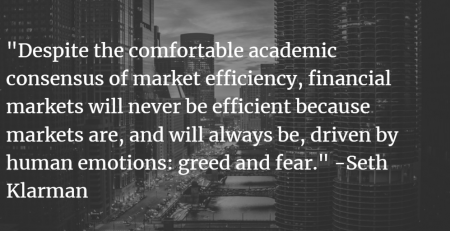Indexing, Benchmarking, and the Problems Therein
We are often asked about our performance relative to an appropriate “benchmark”. For this reason, we often cite our over/under-performance relative to the S&P 500 (the most widely used benchmark, despite significant drawbacks). But please note, we are indifferent to any benchmark, and by no means manage our portfolio with the S&P 500 in mind. And although we have been fortunate enough to out-perform the S&P 500 over many years, it is without a doubt that a period will come when we under-perform it.
This shouldn’t be a cause for concern – it is ultimately the byproduct of us running a concentrated portfolio of high-quality companies. At some point in every cycle, the market starts to abandon quality to chase more “speculative”, less “durable” strategies (as seen in all past market tops). Minsky said it best, “stability leads to instability”. Some managers, when faced with such frothy markets and an overwhelming focus on preserving their short-term relative performance, will jump into any speculative investing fad that is working. We are not those managers.
Instead, we take to heart the lessons of Warren Buffett who famously said, “the less prudence with which others conduct their affairs, the greater the prudence with which we should conduct our own affairs.” To truly practice those words requires us being comfortable with eventually underperforming a market that is in a speculative boom. Otherwise, we would be risking significant losses in order to chase modest gains.
The point of this article is to make sure we are all on the same page with respect to that fact – both new clients and old clients alike. Afterall, our investment performance is a function of our clients sharing our long-term mindset. As such, we thought it would be helpful to talk more broadly about benchmarking, as well as the indexing industry that has risen up to facilitate both benchmarking and the passive investing. More importantly, to talk about the issues therein.
The Rise of ‘Passive’ Index Investing
Consider that in the past, indices such as the Dow Jones, S&P 500, FTSE 100, etc. were primarily used for informational purposes, to benchmark the relative performance of the economy, businesses, and investment managers alike.
Today however, indices have much more power than that – they now control the flow of trillions of dollars of passive funds through their selective inclusion or exclusion of companies. Said another way, indices with their arbitrary rules are increasingly controlling actual financial flows, whereas in the past those flows would have been determined by something as “quaint” as fundamental investment analysis.
It might surprise you to learn that the selecting of what to include in an index is often more political than technical. Human discretion and value judgements play an ever-increasing role in index construction. Outside actors can also have outsized influence on an index’s construction – consider that Chinese authorities have lobbied MSCI, a provider of the leading global index, to include Chinese stocks despite the legal issues in their ownership which we have talked about here.
These ‘passive’ index providers are very much making an ‘active’ decision on whether a company (or even country) should be included or excluded in their index. And those decisions move billions of dollars of real money.
The Basics of Index Construction
How do they construct these indices? The most common approach is the market capitalization weighted method. This simply means that the more that market participants are willing to pay for a company, the more weight that company will have in the index. Notice that we said, ‘the more they are willing to pay’, we did not say the more the company is worth. Market capitalization simply reflects what investors are willing to pay for a company – which is often driven by short-term news flow and sentiment shifts rather than fundamentals (just look at what is going on with GameStop this week, or Tesla this past year).
This market weighted approach has the unintended consequence of making an index less diversified and more fundamentally un-sound during a period of a speculative boom. Consider that today the S&P 500 is almost 40% technology stocks which tend to trade at elevated valuations. As an interesting aside in the arbitrary nature of indices – ‘Communication services’ is a new sector in the S&P 500 invented only 18 months ago to deliberately obscure the dominance of tech in the S&P 500. Stocks now in ‘Communication Services’ used to be classified as Tech, Telco or Media stocks, but are now classified in a way to present a more diversified image to the world. Remember – this is nothing but window dressing, and it did nothing to reduce risk. If anything, it worsened things, as people now think they are taking less risk than they are.
Along with overweighting popular stocks, the reverse is true of unpopular stocks. Take the Energy sector as an example, an enormous industry in real terms, but one which has been shunned by market participants in recent years such that it now makes up less than 2.5% of the S&P 500 – only a marginally larger weight than Tesla by itself.
All of this creates issues for the passive investors that allocate to said indices, and for the professional investors that benchmark to said indices. Consider what happened when Tesla was first included in the S&P 500. Tesla is an example of a business that by almost every conventional metric is obscenely overvalued. Yet, just by including it in the S&P 500, passive investors automatically bought billions of dollars’ worth of its shares and many professional investors then bought billions more as they were terrified of lagging the S&P 500 if Tesla continued to rise. This is clearly not rational investing.
The Problems with Benchmarking
We have talked before about the competitive advantage of a long-term mindset. What we are trying to do in this industry is to harness the wealth creation power of the market by generating enduring returns for years to come. This means focusing on high-quality companies trading at attractive prices. This does not mean chasing whatever is currently working in the markets with no fundamental basis.
Unfortunately, our industry is structured in way that incentivizes professional money managers to do the opposite. After all, most of these managers do not have the luxury of having the long-term focused investor base that we at Globescan have. Instead, these professional money managers are allocated to or redeemed from depending on their recent (often quarterly) performance. Passive and retail investors chasing whichever manager is currently working magnify this effect (just look at ARK investment’s recent inflows).
What this means in practice is that there is tremendous career risk for professional money managers if they deviate heavily from their assigned benchmark. If “technology” is currently outperforming, even if it is due to purely speculative reasons, any professional manager that does not shift into that sector will likely see redemptions.
When the tide turns, and that sector underperforms, the professional manager will at least take solace in knowing everyone else is taking a similar performance hit. Thus, many managers end up largely replicating their benchmarks, which ultimately leads to the same performance as their benchmark but with added fees on top. It is precisely this fact that enables the passive industry to claim so many active managers underperform their index – it is because they are not really active managers.
Rational active investors instead understand that the only way to beat a benchmark is to be different from the benchmark, which often means ignoring it entirely (our favored approach). For example, consider Warren Buffett during the heights of the dot-com bubble, who refused to chase irrational returns despite years of underperforming the market. As history has shown, Buffett strategy was eventually proven to be the more durable.
That is how we operate at Globescan. We largely ignore the market and instead do what we think is right. If we wake up tomorrow and the market is down 30% or up 30%, it doesn’t really matter to us other than to perhaps provide us with transaction opportunities (as we saw in Q1 2020). Instead, what matters to us is whether the underlying earnings power of our businesses are down 30% or up 30%. We will act accordingly based on that information, even if it means going against the crowd.
The key point to understand here is that the cost of durable long-term outperformance is periodic short-term underperformance.
What is the Solution?
The first and most important lesson to takeaway here is that the only durable investment strategy is one that is focused on underlying value and long-term wealth creation. Investment managers that understand this will naturally avoid chasing and mimicking their benchmarks in the short run.
The second lesson to takeaway here is that the only way to judge the efficacy of a long-term wealth creation strategy, is by looking at it over the long term, rather then jumping in and out of it every quarter that it over/underperforms.
For example, consider the business of distilling twelve-year aged scotch. Would it make sense to wait two years and then judge the efficacy of the distiller? Of course not. Similarly, for a long-term investing strategy, that is making investments with holding periods often in the decades, would it make sense to judge the performance of those investments over any single quarter? Of course not. Instead, performance should be measured over rolling three-to-five-year periods to see if a manager is actually adding any value.
For our strategy, measuring our performance against the broader market (S&P 500, Russell 1000, Russell 2000, etc) over periods of greater than three years makes the most sense. After all, despite all the flaws with benchmarking, it does still have a place in our industry if used correctly.
Disclosures: This website is for informational purposes only and does not constitute an offer to provide advisory or other services by Globescan in any jurisdiction in which such offer would be unlawful under the securities laws of such jurisdiction. The information contained on this website should not be construed as financial or investment advice on any subject matter and statements contained herein are the opinions of Globescan and are not to be construed as guarantees, warranties or predictions of future events, portfolio allocations, portfolio results, investment returns, or other outcomes. Viewers of this website should not assume that all recommendations will be profitable, or that future investment and/or portfolio performance will be profitable or favorable. Globescan expressly disclaims all liability in respect to actions taken based on any or all of the information on this website.
There are links to third-party websites on the internet contained in this website. We provide these links because we believe these websites contain information that might be useful, interesting and or helpful to your professional activities. Globescan has no affiliation or agreement with any linked website. The fact that we provide links to these websites does not mean that we endorse the owner or operator of the respective website or any products or services offered through these sites. We cannot and do not review or endorse or approve the information in these websites, nor does Globescan warrant that a linked site will be free of computer viruses or other harmful code that can impact your computer or other web-access device. The linked sites are not under the control of Globescan, and we are not responsible for the contents of any linked site or any link contained in a linked site. By using this web site to search for or link to another site, you agree and understand that such use is at your own risk.






